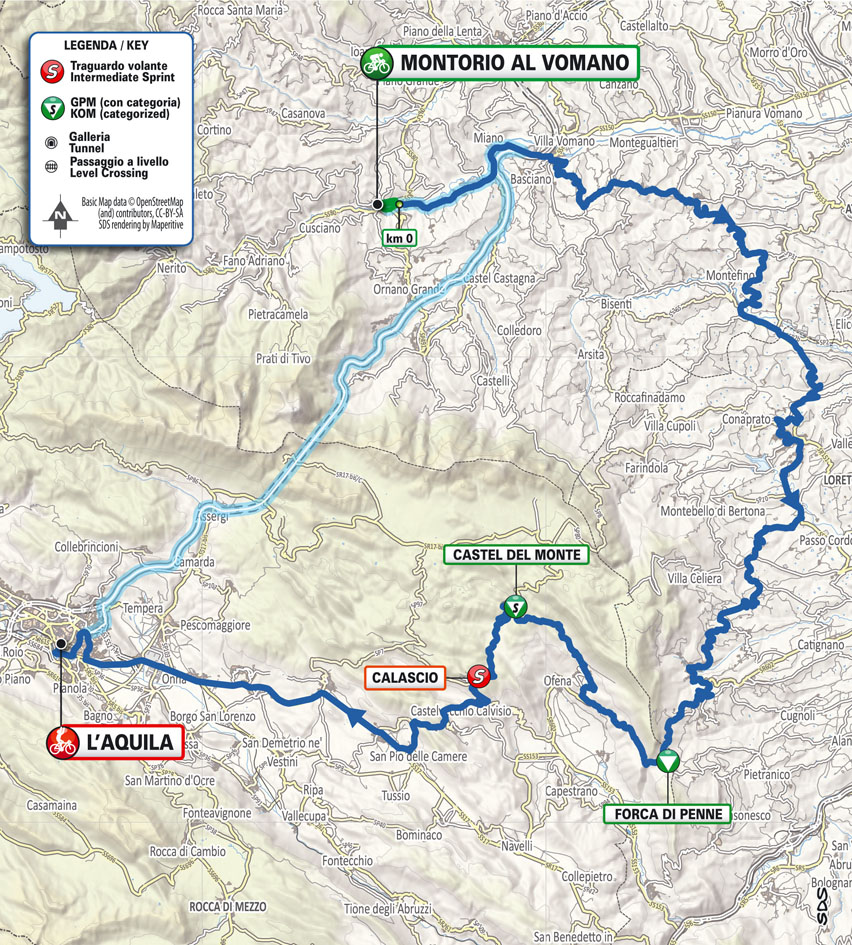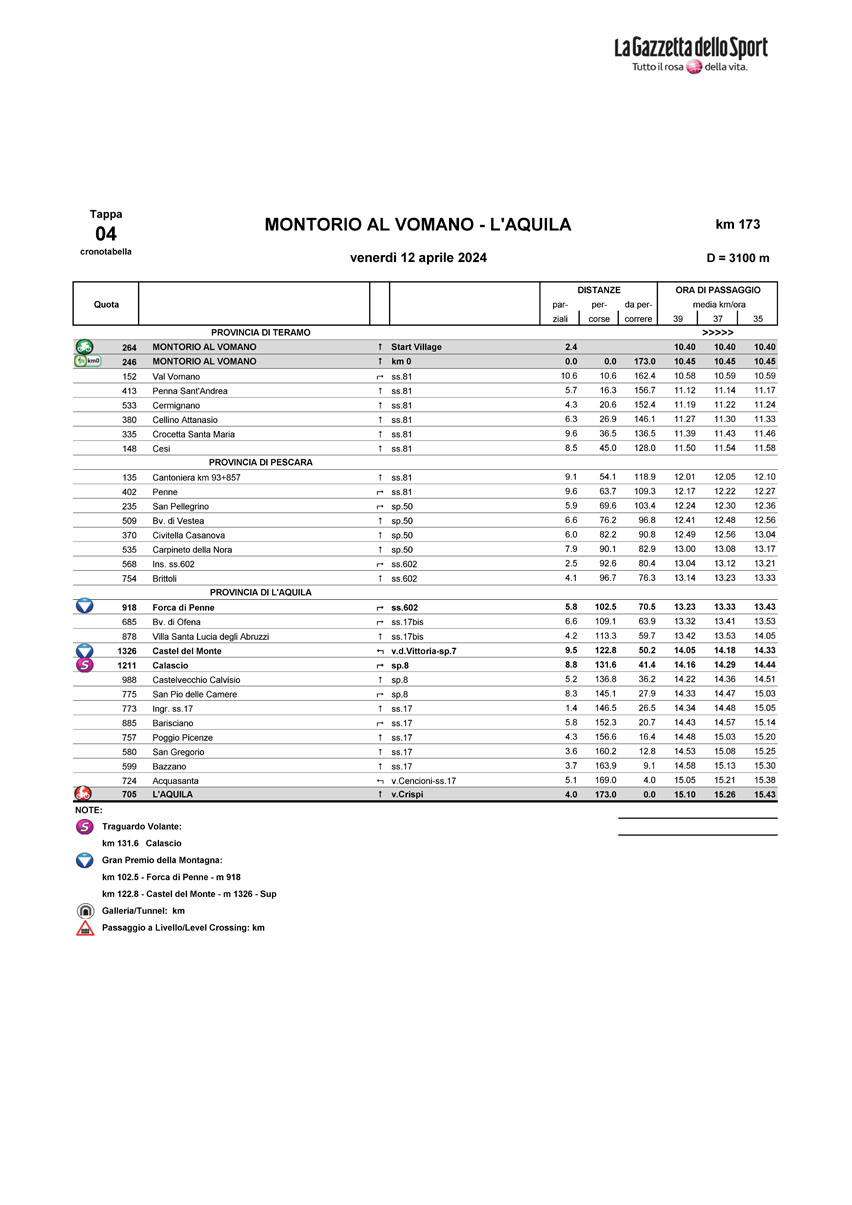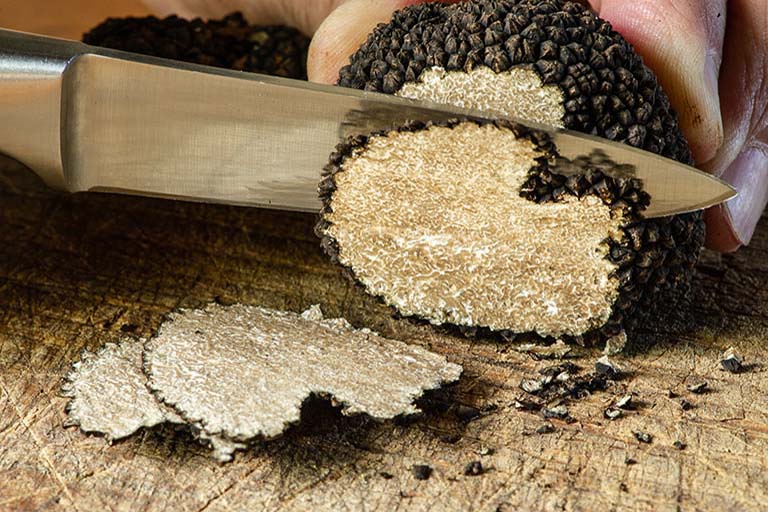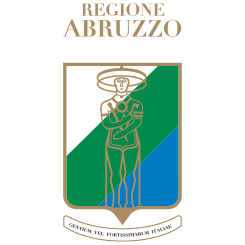profile
map
technical info
This stage consists of a succession of ascents and descents as the race moves from one valley to another, with as many as 12 climbs to be tackled and practically no flat ground to play with. The first part is entirely uphill, touching the villages of Penna Sant’Andrea, Cesi and Penne all the way to Brittoli and Forca di Penne. The athletes will then climb the most demanding hill of the day at Castel del Monte, at the foot of the Gran Sasso, followed by a descent towards Calascio and Castelvecchio Calvisio. The final descent leads to the outskirts of L’Aquila where the short climb of Acquasanta is a prelude to the final sprint down the straight stretch of Via Crispi.
Last km
After leaving the ss.17 road at -6 to go, the peloton will tackle the climb of Via della Polveriera with gradients of around 5-6% and peaks of 9%. The following descent ends with a sharp turn to the right at 2 km from the finish line. At 1500 m to go, the road rises again. The last km has a gradient of around 7% with a peak of 11% a few hundred metres before the final straight. The latter is a 400 m (7 m wide) uphill road at 7%.
start / finish
climb detail
final kilometres
itinerary timetable
tourist info
Host city:
MONTORIO AL VOMANO
L'AQUILA
Overview
L’Aquila, the capital of Abruzzo, is an ancient city whose origins date back to 1254. Distinguished for its history and monuments, it experienced a period of extraordinary economic flourishing throughout the Middle Ages and up to the 16th century, becoming the second largest city in the Kingdom of Naples.
The monumental evidences are framed by a naturalistic context of rare charm, since the city rises at the foot of the Gran Sasso d’Italia massif, surrounded by a mountain habitat rich in woodland and fauna peculiarities and by villages and castles of considerable historical and monumental importance , in an area that is included in two national parks.
Food
The city of L’Aquila and its territory have numerous food and wine excellences. In particular, the saffron, the lentils of Santo Stefano stand out above all, as well as various types of native legumes, and the nougat, a typical dessert of the Christmas tradition. Other typical products of the area are also very well known, such as dairy products, cheeses and cured meats, which have particular processes, as well as liqueurs, among which the gentian one is particularly appreciated.
Points of Interest
The first urban itinerary begins at the basilica of Collemaggio, an exquisite example of Abruzzo architecture in a mixture of architectural styles, from Gothic to Baroque, founded in 1288 by Pietro del Morrone.
Just 200m south we find Parco del Sole, with its lovely natural setting that is home to a playground, a nature trail and a performing arts site housing Beverly Pepper’s Amphisculpture.
The second itinerary starts from the church of Santa Maria del Soccorso (15th century), located to the north-east, outside the urban walls. A striking fusion of Medieval and Renaissance elements, once again using the white–pink intarsia with horizontal listing, it has two distinctive towers. Moving northeast on Viale Panella and then on Via Pescara, we arrive at the Porta Castello gate, erected at the same time as the Spanish fort (16th century). Entering the park, we appreciate the magnificence of the castle. Nearby we find the Auditorium del Parco, a modern wooden performing arts venue, designed by Renzo Piano after the 2009 earthquake. Leaving Piazza Battaglione Alpini, we find the Fontana Luminosa fountain, one of L’Aquila’s iconic monuments, designed by Nicola D’Antino. Just 100m along Via Tre Spighe, we find the Medieval Convent of Sant’Amico with the 15th-century fresco and portal lunette.
Returning to the Fontana Luminosa and heading down Corso Vittorio Emanuele, on the left we find the Nettuno fountain (1881), commemorating Queen Margaret of Austria. Another 200m and we come to the junction with Via Verdi, which leads to the Teatro Comunale (19th century) with its horseshoe interior and stalls, seating 600.
Nearby there is the magnificent basilica of San Bernardino (15th century), in a panoramic position at the top of the staircase in Via Fortebraccio.
The third itinerary starts in piazza Duomo (13th century), with the coeval cathedral of San Massimo (currently closed for restoration), with its Classical revival façade. On the left, the church of Santa Maria del Suffragio (18th century), with an exquisite dome designed by Giuseppe Valadier. The square has two fountains, by Nicola D’Antino and made in local stone, with twin bronze statues. In a few minutes you can reach Piazza Palazzo from here, with Palazzo Margherita (XVI century), recently returned to the city as a Municipal Residence.
The last itinerary starts from the last gate, Porta di Poggio Santa Maria, added after the construction of the railway station (19th century). The fortified walls were about 4km in length and there were 12 gates with 86 towers. The main gates included Porta Rivera, located 400m further east. On the right, we find the scenic Fontana delle 99 Cannelle, a 13th-century fountain and the oldest public monument in the city. It consists of 93 stone masks and 6 single spouts, from which the water flows. Opposite, we find the church of San Vito alla Rivera, of the same period as the walls, its continuous façade clad in white stone.
We are near to the entrance to the MuNDA, national museum of Abruzzo, established in the early 1950s in the historic premises of the Spanish fort, where there are now seven rooms displaying a series of works highly representative of Abruzzo art, from the ancient Abruzzi civilizations to the Baroque period, with archaeological finds, sculptures and paintings.












































